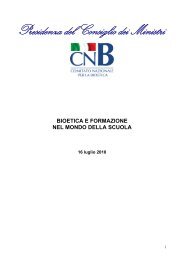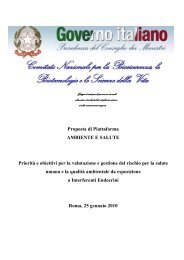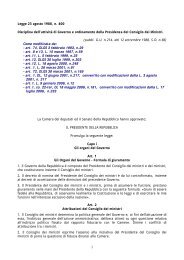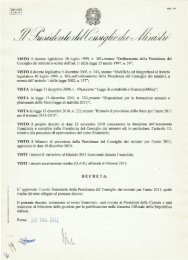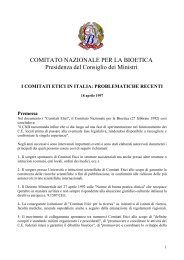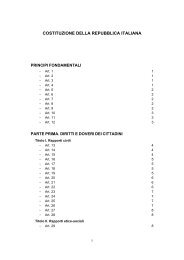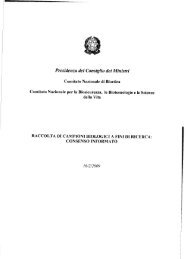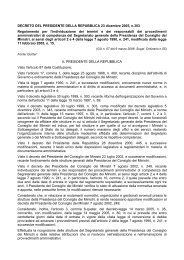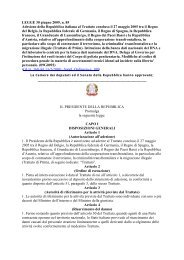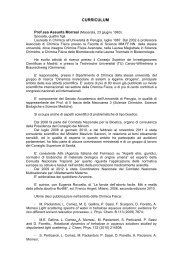President
President
President
You also want an ePaper? Increase the reach of your titles
YUMPU automatically turns print PDFs into web optimized ePapers that Google loves.
cardiac arrests, due to causes that are internal (e.g. arrhythmia) or external<br />
(e.g. incident, mortal trauma) to the organism, whilst it is subject to different<br />
medical and ethical assessments when it is an event due to serious illnesses,<br />
in advanced state and terminal 249 .<br />
Although a 10 minute period of absolute lack of cardiac activity –<br />
ascertained with certainty – is to be considered an element of high likelihood of<br />
the death of the human being, caution forces us to avoid reducing below 20<br />
minutes the temporal limit of the wait before starting, on the body of the dead<br />
patient, the “technical” procedures that will allow the subsequent removal of<br />
organs. It follows that in Italy – should this practice develop – the eventual<br />
protocols used in the various hospitals for the purpose of removing organs from<br />
a non-heart-beating patient are not and must not be due to isolated or<br />
autonomous decisions, but must be elaborated following the law and its<br />
foundation, approved by the national guarantor authority (National Transplant<br />
Centre) 250 . The centres that will eventually be authorised, will also need to be<br />
made up of particularly qualified personnel, trained in the specific needs of<br />
these cardiological damages, and a public support network for those individuals<br />
suffering from cardiac arrest will have to be guaranteed, endowed with high<br />
efficiency and fast intervention times, with the aim of ensuring first of all a better<br />
chance of resuscitation.<br />
The NBC believes that it is also indispensable to consider the international<br />
scientific debate and to increase the observational studies to verify the scientific<br />
possibility to anticipate the certain and irreversible identification of cardiac<br />
death or the eventual possibility of a temporal limit susceptible to variation case<br />
by case, also taken into account the difference between the diagnosis of<br />
cardiac death in adults and children. The Committee recommends that in<br />
determining this, there should be no place for economical or pragmatic<br />
reasons.<br />
At the basis of this issue is also the question of whether it is ethically<br />
legitimate to interrupt resuscitation procedures that don’t cause suffering, but<br />
“stabilise” the individual’s vital signs (although precarious). For some, the<br />
problem turns into that of therapeutic persistence, for others medical assistance<br />
is intended as an act due to the individual who still shows vital signs. In<br />
addition, at least in the experience already documented on various occasions in<br />
the USA, it is not the individual’s expression of will to “not be resuscitated” or to<br />
interrupt resuscitation treatments objectively considered unproductive (situation<br />
of therapeutic futility), but the assessment of the relatives and/or the legal<br />
representative, which is considered important. The situation is therefore often<br />
extremely complex from an ethical point of view.<br />
Within these protocols, even before ascertaining death with cardiocirculatory<br />
criteria (flat line ECG for 20 minutes) and only after an evident lack<br />
of reaction to cardio-respiratory resuscitation attempts, the NBC believes that<br />
some technical actions that do not damage the patient are legitimate, if they are<br />
aimed at “achieving control for donation purposes after cardiac death” and as<br />
249 In the cases included in the first hypothesis, assistence must be as quick as possible,<br />
because after a few minutes from the cardiac arrest (asystole) the damage – particularly brain<br />
damage – is serious and frequently fatal. The faster the transport and the care of hospital<br />
experts (A&E and intensive therapy centres), with the application of all the adequate criteria of<br />
cardiopulmonary resuscitation (mechanical and pharmacological instruments), the higher the<br />
chance of survival.<br />
250 As the already mentioned Alba Protocol currently does.<br />
179




